How Frederick Douglass Elementary is Changing the Way School Works
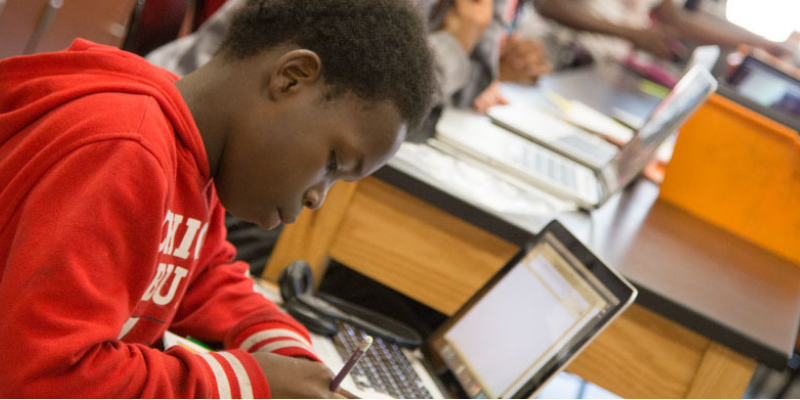
James M. Loy, Miami University
It’s 9am on a Friday morning, and students throughout Frederick Douglass Elementary are eagerly working on all sorts of imaginative projects.
In one class, students are learning about urban development by designing 3D models of their local neighborhood. In another, social studies students demonstrate their knowledge of agricultural advancements by proudly explaining the Aztec villages they built. Soon, they’ll also be scripting and recording their own talk shows to reenact more historical aspects of this ancient culture.
Downstairs, Kamyia Fletcher’s second-grade students are learning about black leaders and making African kente cloths to add to their own freedom quilt.
“The goal is to help them understand themselves, and then understand where we come from, so we know where we’re going,” Fletcher says. Which might also be an apt way to describe the journey this entire school is on.
Because things here are changing.
A rising rank
As part of Cincinnati Public Schools, Frederick Douglass serves grades K-6, and it’s located in one of the city’s most culturally diverse neighborhoods. Many students come from low income or underserved areas. And not long ago, it was ranked as a failing school by the Ohio Department of Education.
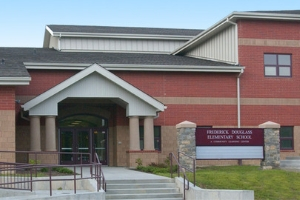
Today, however, the school has risen from an F to a B in Closing the Gap. It’s no longer being targeted by Ohio as a warning school. It’s been removed from that particular list. Plus, Douglass’ long history of chronic absenteeism is finally going down.
“That's huge,” says, Frederick Douglass Principal and Miami University graduate
Jeffery Hall. “Those are three successes for us. That’s a big deal.”
So the kind of engagement now happening across Douglass is all part of a larger plan to rethink teaching and learning. And so far, it’s working.
“I wanted to do something game-changing in the educational field,” Hall says. “The goal is to be the number one elementary school in the state of Ohio, and it's going take some non-traditional strategies to get us there.”
A new vision
While the turnaround is still ongoing, much of the progress can be traced back to Hall’s vision to set higher expectations and offer more opportunities, which has led to several key programs, partnerships, and approaches that have helped transform the school’s entire culture.
Things are “110%” different now, Hall says, and the evidence is everywhere.
A new contemplative arts and sciences program, for example, was introduced to help students build cognitive skills such as self-awareness and self-control. And an award-winning dance company from Dayton, Ohio, was brought on to teach students how movement and motion can increase focus and productivity.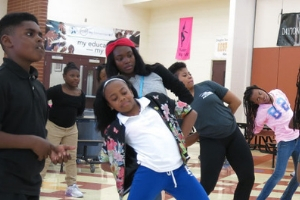
A new partnership with the nearby Walnut Hills High School --which is consistently ranked among the top 100 public high schools in the country -- allowed Douglass to offer 20 new after-school activities and mentorship programs including swimming, choir, robotics, 4-H, gardening, and more.
Looking to his own alma mater, Hall also established a relationship with the department of teacher education at Miami University.
“Most fortune 500 corporations have test facilities, and I wanted to be a test facility for Miami University students that want to be teachers in our urban setting,” Hall says. “So we began to work towards becoming a professional development school. We established a relationship, and we began to change the culture and move it in the right direction.”
This partnership began nearly 4 years ago, and it’s become “a win for the university and a win for our school,” Hall says.
Miami students get professional experience in real classrooms, and several have been hired on as fulltime Douglass teachers. Of course, the elementary school benefits from the extra assistance. But Miami faculty also regularly host professional development workshops to keep teachers up on current educational trends.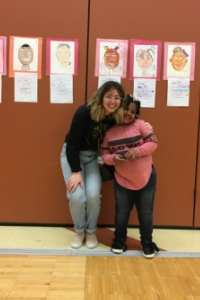
“What we're doing with Miami is non-traditional,” Hall says. “I don't know another university that has put in this amount of time or effort in into an elementary school, and we’re beginning to see the gains finally.”
Project-based learning
But perhaps the most significant non-traditional change has been the way Douglass students now engage with the actual classroom content, which has begun emphasizing an approach called project-based learning.
Rather than relying on a scripted curriculum or standardized lesson plans, project-based learning (PBL) creates educational experiences that are richer and more nuanced. Proponents say PBL helps students develop academically and emotionally by focusing on critical thinking, problem- solving, and teamwork skills. And it often uses culturally relevant topics, real-world challenges, and even local issues to encourage students to explore their own curiosity and creativity.
So when those students built that 3D model of their local neighborhood, the project became more than just a lesson on urban development. It also connected to another issue in their life.
“We researched it. We partnered with the sixth-grade class. We made a 3D model,” says Douglass educator Zoe Scaglia. “And then, we talked about what buildings were missing, so we could talk about the gentrification of their neighborhoods. Because last year there was a lot of new development, and it was a really powerful way for them to process what's going on.”
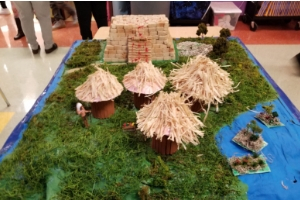 Similarly, when Lynn Collins’s social studies class studied Aztec agriculture by building their own villages and producing their own videos, the project inspired them in ways a worksheet rarely would.
Similarly, when Lynn Collins’s social studies class studied Aztec agriculture by building their own villages and producing their own videos, the project inspired them in ways a worksheet rarely would.
“To have them construct this and video it is just as valuable as a learning tool as it is for me to open a textbook and read a chapter with them,” Collins says. “They know this. They take ownership with this. This is their project. They can explain it. They know exactly what they learned from it.”
These projects are just a snapshot, just a few of the things happening at Douglass today.
Soon, Hall plans to integrate more technology, which he wants to use to collaborate with even more schools, globally. He also hopes to expand the partnership with Miami University. And the momentum behind the school’s relationship with the students and with the community will continue to build.
“We're a work in progress,” Hall says. “It's easy for people to go back to their comfort zone. So we have to constantly continue to talk about the culture and continue to change the culture. And the things that helped us change, and helped us be successful, we have to continue to do those things. We have to remember, we're not number one yet. We still have a lot of work to do.”

